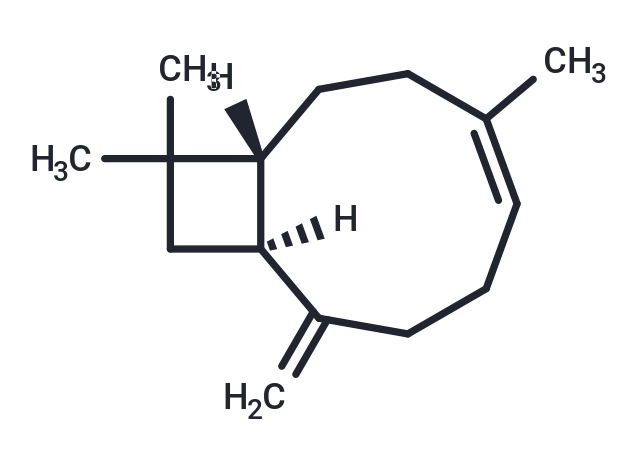Shopping Cart
Remove All Your shopping cart is currently empty
Your shopping cart is currently empty
β-Caryophyllene ((-)-(E)-Caryophyllene) acts as an CB2 receptor agonist.

| Pack Size | Price | USA Warehouse | Global Warehouse | Quantity |
|---|---|---|---|---|
| 200 mg | $30 | In Stock | In Stock | |
| 500 mg | $41 | In Stock | In Stock | |
| 1 g | $56 | In Stock | In Stock | |
| 2 g | $80 | - | In Stock | |
| 5 g | $129 | - | In Stock | |
| 10 g | $189 | - | In Stock |
| Description | β-Caryophyllene ((-)-(E)-Caryophyllene) acts as an CB2 receptor agonist. |
| In vitro | β-Caryophyllene shows selective anti-proliferative effects against three tested cancer cell lines: HCT 116 (colon cancer, IC50=19 μM), PANC-1 (pancreatic cancer, IC50=27 μM), and HT29 (colon cancer, IC50=63 μM), but exhibits moderate or poor cytotoxicity against ME-180, PC3, K562, and MCF-7. It demonstrates higher selectivity for colorectal cancer cells, particularly HCT 116 (SI=27.9), followed by PANC-1 (SI=19.6) and HT 29 (SI=8). The apoptotic index for HCT 116 cells after 24 hours of β-Caryophyllene treatment is 64±0.04. At 10 μM, it causes significant nuclear condensation after 6 hours and exhibits dose- and time-dependent inhibitory effects on HCT 116 cell motility. |
| In vivo | During the examination period, administering varying doses of β-Caryophyllene had no impact on swimming speed. However, oral administration of β-Caryophyllene significantly reduced β-amyloid deposition in transgenic mice in a nearly dose-dependent manner, with the two highest doses showing comparable efficacy in decreasing β-amyloid accumulation. Notably, vehicle-treated mice displayed an increased number of activated astroglial cells compared to those treated with any dose of β-Caryophyllene. Furthermore, β-Caryophyllene effectively lowered the elevated COX-2 protein levels observed in vehicle-treated APP/PS1 mice. Additionally, animals receiving β-Caryophyllene treatment demonstrated a higher object recognition index than their vehicle-treated counterparts, indicating improved memory retention [t(14)=4.204, P<0.05]. There was no significant difference in the total time spent exploring objects between the β-Caryophyllene and vehicle-treated groups during the test trial (t(14)=0.5874, P>0.05). β-Caryophyllene treatment did not significantly affect seizure-induced neurochemical alterations. |
| Cell Research | Stock solution (10 mM) of β-Caryophyllene is prepared using DMSO. Further, various concentrations (3 to 100 μM) of β-Caryophyllene are prepared by serially diluting the stock with respective culture medium.Panel of human cancer cells such as, pancreatic (PANC-1), colorectal (HCT-116 and HT-29), invasive squamous cell carcinoma (ME-180), leukemia (K562), hormone sensitive and invasive breast cancer cell line (MCF-7), and prostatic (PC3) adenocarcinoma cell lines are used. Cells are incubated in a humidified CO2 incubator at 37°C supplied with 5% CO2. Inhibitory effect of β-Caryophyllene on proliferation of the cell lines is tested using the MTT assay. The selectivity index (SI) for the cytotoxicity of β-Caryophyllene is calculated using the ratio of IC50 of β-Caryophyllene on a normal cell line (NIH-3T3) to the IC50 of β-Caryophyllene on cancer cell lines. They are for reference only. |
| Animal Research | β-Caryophyllene is initially dissolved in dimethyl sulfoxide and further diluted (2%) in sterile phosphate-buffered saline (PBS) with 10% Cremophor EL (poluoxyl-35 hydrogenated castor oil).Male double transgenic APP/PS1 mice and wild-type littermates are used. The mice are group housed (3 to 5 animals/cage) with a 12:12-hour light/dark cycle and ad libitum access to food and water. In this experiment, animals are orally treated by gavage with 16, 48, or 144 mg/kg of β-Caryophyllene every morning for 10 weeks starting at the age of 7 months. All vehicle solutions are used for the respective control animal treatments and the Morris water maze test is performed. They are for reference only. |
| Synonyms | (−)-β-caryophyllene, (−)-trans-Caryophyllene, (-)-(E)-Caryophyllene |
| Molecular Weight | 204.35 |
| Formula | C15H24 |
| Cas No. | 87-44-5 |
| Smiles | [H][C@]12CC(C)(C)[C@]1([H])CC\C(C)=C/CCC2=C |
| Relative Density. | 0.901 g/cm3 at 25℃ (lit.) |
| Storage | Powder: -20°C for 3 years | In solvent: -80°C for 1 year | Shipping with blue ice/Shipping at ambient temperature. | |||||||||||||||||||||||||||||||||||
| Solubility Information | DMSO: 25 mg/mL (122.34 mM), Sonication is recommended. Ethanol: 176.67 mg/mL (864.55 mM), Sonication is recommended. H2O: < 0.1 mg/mL (insoluble) | |||||||||||||||||||||||||||||||||||
| In Vivo Formulation | 10% DMSO+40% PEG300+5% Tween 80+45% Saline: 2 mg/mL (9.79 mM), Sonication is recommended. Please add the solvents sequentially, clarifying the solution as much as possible before adding the next one. Dissolve by heating and/or sonication if necessary. Working solution is recommended to be prepared and used immediately. The formulation provided above is for reference purposes only. In vivo formulations may vary and should be modified based on specific experimental conditions. | |||||||||||||||||||||||||||||||||||
Solution Preparation Table | ||||||||||||||||||||||||||||||||||||
DMSO/Ethanol
| ||||||||||||||||||||||||||||||||||||
| Size | Quantity | Unit Price | Amount | Operation |
|---|

Copyright © 2015-2025 TargetMol Chemicals Inc. All Rights Reserved.